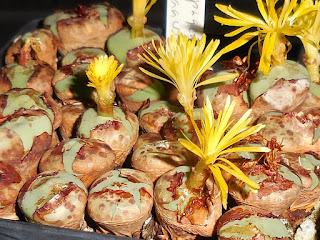 |
Prunus maritima f. gravesii at the University of Connecticut, May 13, 2024
|
For this year's Endangered Species Day I thought I'd post about Graves' Beach Plum, which is about as endangered as a plant can get without being extinct, but which is also arguably not a species. Prunus gravesii was described in 1897, based upon what was likely a single plant with multiple stems, found growing near the shoreline in Groton, Connecticut. Later authors demoted the species to a variety, and then a form, of the widespread Beach Plum, Prunus maritima, and it is now usually referred to as Prunus maritima forma gravesii.
Graves' Beach Plum native range was always minute, and the wild habitat of the shrubs apparently suffered during the 20th century from development, possible herbicide use, and the spread of invasive plants. By 1998, Graves' Beach Plum was apparently completely gone from its former habitat, extinct in the wild. Some internet sources have it that the little grove of Prunus m. f. gravesii was the only shelter near a beach without facilities, and the area was used as an open air restroom so much that all the plants died, but this seems to be a fairly recently invented legend.
Prunus m. f. gravesii is extinct in the wild, not extinct extinct, because various botanical gardens and a few private individuals maintain the plant in cultivation. The New York Botanical Garden and the University of Connecticut Botanical Conservatory have kept it going for many years, and UConn has sent plants to the Arnold Arboretum and few other gardens.
 |
Graves' Beach Plum foliage.
|
Graves' Beach Plum turns out to be charming ornamental shrub for sites in full sun, near the coast or otherwise. In mid-May it is completely covered by small white flowers, which attract large numbers of bumblebees, mason bees, and other native pollinators. The plants can be propagated with some difficulty by stem cuttings, but more easily by dividing out the suckers that sometimes grow from the roots. Grave's Beach Plum differs from typical
Prunus maritima most obviously in its smaller, more rounded leaves, but the entire plant is more delicate than the usual beach plum, with thinner twigs and smaller flowers and fruit. Fruit set in
Prunus m. f. gravesii is never very abundant, and it apparently needs to outcross with other
Prunus maritima to set seed, so seedlings are never pure
gravesii.
 |
Flowering shoots of typical Prunus maritima (top) and Prunus maritima f. gravesii (bottom).
|
Reference: Klooster, M.R. et al. 2018. Resolving the taxonomic identity of
Prunus maritima var.
gravesii (Rosaceae) through genotyping analyses using microsatellite loci.
Rhodora 120: 187-201.








